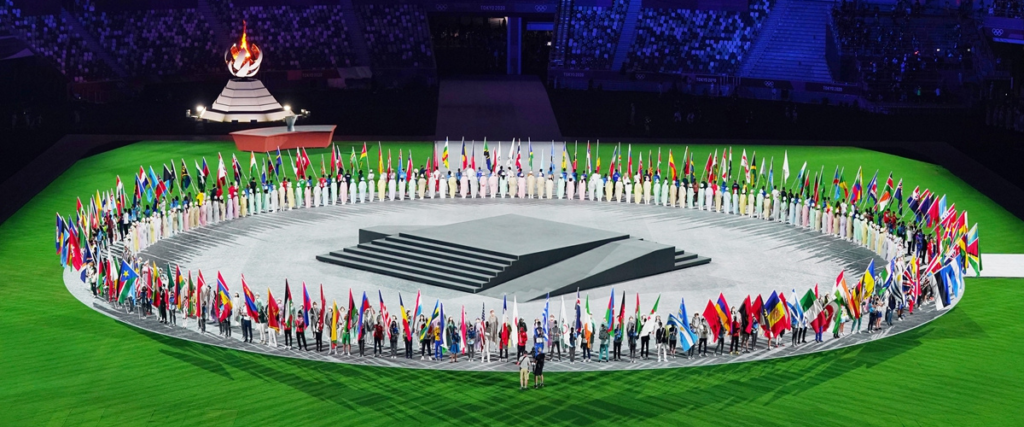Helmed by industry leader, Toyota, the recent Tokyo Olympics technology showcase was innovative and cutting-edge, giving many benefits to all involved in the 2020 Olympic Games. Whether it be the reappearance of existing technology, or a clever innovation, the most recent Olympic Games was a playground for Toyota’s innovative technology.
The long-awaited Tokyo 2020 Olympic Games ended successfully in the first week of August. While many were keeping up with the outstanding performances of athletes, the Tokyo Olympics technology scene caught the attention of others. Compared to prior years, great advances in technology were apparent, ranging from the grand opening and closing ceremony light show, to sport wearables and human support robots. As diverse as the applications of technology were, there are also a lot of innovative creations to uncover, so read on for a roundup of the most exciting high-tech features of the Tokyo 2020 Olympic Games.
Intel Drone Light Show
For the grand opening and closing ceremonies of the Olympics, Intel’s drone light show took the spotlight, putting on a mesmerising show for the world. The tech firm’s fleet of 1,824 premium drones, weighing less than 340 grams each, shot to the sky in unison to complete a flawlessly synchronised light show. Equipped with high-tech coloured LED lights, each drone had a real-time kinematic GPS system. To celebrate the unification of the 205 Nations participating in the Olympic Games, the drones ended the show by assembling a 3D model of the earth, symbolising global solidarity. The tracking GPS feature facilitated the smooth movements and high spatial accuracy required to produce a seamless 3D animated performance.
Toyota Service-bots
Toyota Motor Corporation, an industry leader in robot technology, released four new robots for a more convenient and efficient Olympics experience. Each robot served a purpose to ensure fluid logistics behind the scenes. This included welcoming guests, delivering virtual audiences with a realistic experience, and assisting with equipment delivery. Among the four robots, Toyota’s Field Support Robot (FSR) played a vital role in equipment and events management. Equipped with an AI-powered automatic driving function, the FSR determined the optimal route for retrieving used equipment after athletes competed.
The unique functions of the FSR allowed for expedited retrieval of equipment, and easier navigation for staff. Furthermore, while these tasks could have been completed with manpower, the human supporting robotic system helped decrease the frequency of human contact at the Olympic Games, offering a smart socially distanced solution.

Wearable Cooling Technology
Another way advanced technology was showcased at the Tokyo Olympics was in the form of wearable technology. While high-tech materials have been used before in swimwear to streamline athletes’ bodies against water resistance, this year, it was designed to keep athletes’ cool and comfortable in the Tokyo summer heat.
American fashion brand Ralph Lauren created the opening ceremony uniform for Team USA as a solution. The new wearable technology named “RL Cooling” incorporates Ralph Lauren’s latest RL Cooling Technology to regulate temperature cooling for the athletes.
Ralph Lauren has engaged with temperature regulating technology before, the most noteworthy being their creation of the Ralph Lauren Self-Heating Jacket which was released at the PyeongChang 2018 Winter Olympics 2018. Similarly with this year’s release, heat detecting functions sense body temperature, allowing ventilation through the clothing to prevent overheating. The design of the uniform has a battery-powered fan-like device located at the back of the jacket. The cooling device disseminates accumulated body heat, bringing a long-lasting cooling sensation.
Ralph Lauren stated its production of wearable technology reflects on the brand’s interest in sustainability initiatives. The United States Department of Energy supported these claims suggesting that individual thermal regulation has potential to reduce usage of high energy-consuming electronic systems.

Toyota’s Autonomous Cars
Toyota’s driverless car, the e-Palette, made its first debut at the 2018 Consumer Electronics Show (CES). At the event, Akio Toyoda, president of Toyota, also revealed the firm’s goal of becoming a mobility company.
The e-Palette was used in both the 2020 Olympics and Paralympics, to ferry athletes in and out of the Olympic Village. Each e-Palette had the capacity for up to 20 people, or 4 wheelchairs. The driverless vehicle is powered by lithium-iron battery packs which can be recharged after use. A fully charged e-Palette can cruise at a maximum speed of 20mph, covering on average of 90 miles. With the release of the e-Palette, Toyoda explained the firm’s intention to create a vehicle aimed to support practical Maas (Mobility as a Service). MaaS refers to integrating various forms of transport services into a single mobility service that is accessible on demand. Well known MaaS brands are Uber and Citymapper.
As complex as the technology behind the e-Palette is, safety is always a main concern. Despite the absence of a driver, there is a safety staff member in each vehicle to ensure seamless operations every ride. In addition, Toyota fitted the e-Palette with the updated version of its Safety Sense technology, for effective and safe conduction.

The diversity and complexity of technology launched at the Olympic Games marks a new digital era. While the Olympics provided a stable ground for test runs for Toyota, the industry leader intends to fully implement its innovations in future Olympic Games and international sporting events.
Featured banner image: Xinhua via globaltimes.cn
Related Articles:
6 Tech Trends Transforming the Automotive Industry





